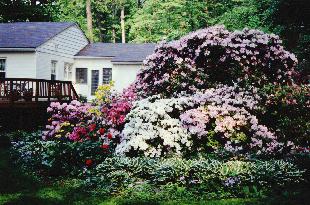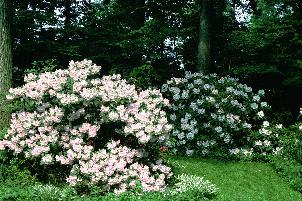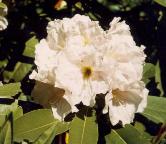Intoduction
 Some of the most reliable rhododendron hybrids for the Middle Atlantic Region of the United States are the hybrids produce by Joseph B. Gable of Stewarstown,
Pennsylvania. Pictured to the right is a 30 year old plant of one of his hybrids, 'Caroline', towering above azaleas and hosta in my own back yard.
Some of the most reliable rhododendron hybrids for the Middle Atlantic Region of the United States are the hybrids produce by Joseph B. Gable of Stewarstown,
Pennsylvania. Pictured to the right is a 30 year old plant of one of his hybrids, 'Caroline', towering above azaleas and hosta in my own back yard.
Joe Gable was born in 1886 and grew up on the family apple orchard and
farm near Stewartstown and by 1926 had started a small nursery business, published his first listing of ornamental plants for sale. Originally offering a variety of young evergreens, trees and shrubs including some native azaleas and rhododendrons, Gable's primary interest eventually shifted to developing rhododendrons and azaleas that could survive the rigorous climate in central Pennsylvania.
For over 40 years, Gable experimented with rhododendrons and azaleas, trying to raise rare species and create new hybrids. He frequently corresponded with contemporaries such as Guy Nearing and other experts from around the world as he expanded his interest in rhododendrons. He obtained seed and pollen from many sources that he used when hybridizing rhododendrons on his farm in rural Pennsylvania. Gable did not pamper his rhododendrons, but planted thousands of seedlings in the woods and let the plants fend for themselves until he was ready to evaluate them, many years later. Although the Gable Study Group identified approximately 100 named rhododendron hybrids, another 100 rhododendron species Gable tried,and at least 90 different group crosses, Joe Gable's rhododendrons are still relatively scarce in the trade. The Gable rhododendrons are real survivors though, and many have proven to be among the most reliable rhododendron hybrids for our region.
|
The Gable Rhododendron Hybrids

Some of Joe Gable's rhododendrons were named for family members, such the pale lavender pink "Caroline" for his daughter, Caroline Gable, who passed away not long ago. He named an evergreen azalea "Caroline Gable", too. Among his hybridizing triumphs is the ruffled, peachy pink and yellow rhododendron "Mary Belle", the plant he named for his wife, the former Mary Belle Dalton whom he married in1919.
Some Gable rhododendrons have rather unusual names since Gable often named his hybrids by combining the first few letters of each parent. Pictured to the right is the pale pink show stopper in my back yard, "Cadis", a hybrid of Caroline and the species, R. discolor. Further in the background of that picture is the blush white "Disca", reported to be the reverse cross. "Maxhaem Salmon" is a salmon selection from a cross of hardy R. maximum and the tender R. haematodes. There is also a "grex" or hybrid group he referred to as "Catfortcampy", a number of beautiful apricot pink hybrids from a cross of R. catawbiense, R. fortunei, and R. campylocarpum.
 No matter what they are called, the Gable rhododendrons such as 'Disca' pictured to the left are fantastic garden plants that are not only beautiful as any hybrids on the market, but are as rugged as any rhododendrons for our region.
Every year, I watch my Gable rhododendrons become more majestic with each season. If developers do not turn my garden into townhouses after I am gone, have little doubt that centuries from now "Caroline", "Cadis", and "Disca" will have grown together forming a fragrant rhododendron canopy that will rival the oaks that shade my garden now.
No matter what they are called, the Gable rhododendrons such as 'Disca' pictured to the left are fantastic garden plants that are not only beautiful as any hybrids on the market, but are as rugged as any rhododendrons for our region.
Every year, I watch my Gable rhododendrons become more majestic with each season. If developers do not turn my garden into townhouses after I am gone, have little doubt that centuries from now "Caroline", "Cadis", and "Disca" will have grown together forming a fragrant rhododendron canopy that will rival the oaks that shade my garden now.
|